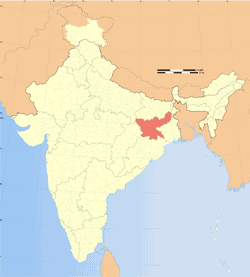Bangor, Gwynedd, United Kingdom
June 10, 2009
 A
novel upland rice variety, Birsa Vikas Dhan 111 (PY 84),
has recently been released in the Indian state of Jharkhand. It
was bred using marker-assisted backcrossing with selection for
multiple quantitative trait loci (QTL) for improved root growth
to improve its performance under drought conditions. It is an
early maturing, drought tolerant and high yielding variety with
good grain quality suitable for the direct seeded uplands and
transplanted medium lands of Eastern India. A
novel upland rice variety, Birsa Vikas Dhan 111 (PY 84),
has recently been released in the Indian state of Jharkhand. It
was bred using marker-assisted backcrossing with selection for
multiple quantitative trait loci (QTL) for improved root growth
to improve its performance under drought conditions. It is an
early maturing, drought tolerant and high yielding variety with
good grain quality suitable for the direct seeded uplands and
transplanted medium lands of Eastern India.
This is the first example of a rice variety bred through the
combined use of marker-assisted selection and client-oriented
breeding, and is a rare success story for the use of
marker-assisted selection to improve a quantitative trait. It
out-yields the recurrent parent by 10% under rainfed conditions.
The variety was developed in a collaborative partnership between
CAZS Natural Resources, Bangor
University, UK; Gramin
Vikas Trust, Ranchi, Jharkhand, India and
Birsa Agricultural
University (BAU), Ranchi, Jharkhand, India. The target QTL
were first identified by Adam Price (now at Aberdeen University,
UK) and Brigitte Courtois (CIRAD,
France/IRRI, Philippines).
Kalinga III was chosen as the recurrent parent for desirable
traits that had been identified in participatory trials, and
because farmers in western India states had already adopted it
outside its initially recommended area.
Three genomic regions carrying root growth QTL on chromosomes 2
(root length), 9 (root thickness) and 11 (root penetration) were
transferred from the donor Philippines variety Azucena into the
recurrent parent Kalinga III. Selected backcrossed lines were
crossed to pyramid the QTL. Selection was made in early
generations using RFLPs and in later generations using
microsatellite markers flanking QTL on chromosomes 2
(RM221-RM213), 9 (RM242-RM201) and 11 (RM229-RM206). The maximum
length of an introgressed region was 40 cm on chromosome 2.
Background selection was made for Kalinga III alleles on target
chromosomes but it was not complete across all other
chromosomes.
In participatory trials, farmers selected it for its superior
phenotypic performance. Farmer-selection was made in the target
environment of farmersí fields in Jharkhand, Orissa and West
Bengal from 2001 and in low-fertility soil of GVT-BAU Research
Farm, Ranchi.
The release of Birsa Vikas Dhan 111 has paved the way for
certified seed production in Jharkhand, which has a population
of over 21 million people, of whom 44% live in poverty. Rice is
the staple food. About 46% of the land is rainfed upland, where
rice is grown by resource-poor smallholder farmers (most have
less than 2 ha of land) who depend on agriculture and migrate to
find other work. Low and erratic rainfall cause frequent
droughts across the region.
Other news
from Birsa Agricultural University /
from
Gramin Vikas Trust
Graphics credit: Wikipedia |
|